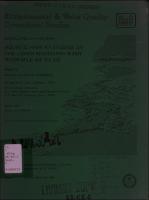Please use this identifier to cite or link to this item:
https://hdl.handle.net/11681/3012Full metadata record
| DC Field | Value | Language |
|---|---|---|
| dc.contributor | Environmental and Water Quality Operational Studies (U.S.) | - |
| dc.contributor.author | Cobb, Stephen P. | - |
| dc.contributor.author | Clark, Jonathan R. | - |
| dc.date.accessioned | 2016-03-15T20:26:53Z | - |
| dc.date.available | 2016-03-15T20:26:53Z | - |
| dc.date.issued | 1981-03 | - |
| dc.identifier.uri | http://hdl.handle.net/11681/3012 | - |
| dc.description | Miscellaneous Paper | - |
| dc.description | Abstract: To provide data for design of field studies to determine the impacts and ecological value of the man-made habitats formed by dike and revetment structures in the Lower Mississippi River, the aquatic habitat of a 50-mile reach of the river (mile 480 to 530 Above Head of Passes, AHP) was quantitatively mapped to determine spatial relationships among and within habitat function of river stage and discharge. Twelve aquatic habitat types were defined within the study reach based on hydraulic, geomorphological, and ecological criteria: main channel, natural banks, revetted banks, sandbars, dike fields, permanent and temporary secondary channels, abandoned river channels (Types I and II), oxbow lakes, borrow pits, and inundated floodplain. By use of controlled aerial photography and hydrographic survey data, aquatic habitat surface acreages were computed for three river stages (low flow = +13.2 ft, medium flow = +24.6, and high flow = +38.4 ft on the Greenville, Mississippi, gage). Results of the habitat mapping revealed a significant change in total aquatic habitat acreage with changes in river stage and discharge. At the low flow stage 18,581 acres of habitat were present. Habitat area increased to 29,020 acres at medium flow and rose to 56,902 acres for high flow -- a total increase of 222 percent in area over low flow conditions. The main channel was the predominant habitat type during the low flow period, composing 45 percent of total habitat. Dike fields and the main channel were the most abundant habitat types at medium flow, making up 28 and 29 percent of total habitat, respectively. For the high flow period, inundated floodplain habitats were the most common habitats, comprising 27 percent of the total aquatic habitat. Variation in river stage and discharge caused a significant change in the spatial relationships among and within habitat types. The habitat mapping technique used in the studies was found to be a convenient and efficient technique to stratify large river systems for designing field sampling efforts for evaluating impacts of Corps flood control and navigation projects. This is Report 2 of the series "Aquatic Habitat Studies on the Lower Mississippi River, River Mile 480 to 530." | - |
| dc.publisher | Environmental Laboratory (U.S.) | - |
| dc.publisher | Engineer Research and Development Center (U.S.) | - |
| dc.relation | http://acwc.sdp.sirsi.net/client/en_US/search/asset/1040563 | - |
| dc.rights | Approved for public release; distribution is unlimited. | - |
| dc.source | This Digital Resource was created from scans of the Print Resource | - |
| dc.subject | Aquatic habitats | - |
| dc.subject | Mapping | - |
| dc.subject | Aquatic life | - |
| dc.subject | Aquatic ecology | - |
| dc.subject | Aquatic biology | - |
| dc.subject | Maps | - |
| dc.subject | Lower Mississippi River | - |
| dc.title | Aquatic habitat studies on the Lower Mississippi River, river mile 480 to 530. Report 2, Aquatic habitat mapping | - |
| dc.type | Report | en_US |
| Appears in Collections: | Miscellaneous Paper | |
Files in This Item:
| File | Description | Size | Format | |
|---|---|---|---|---|
| MP-E-80-1-Report-2.pdf | 7.48 MB | Adobe PDF |  View/Open |